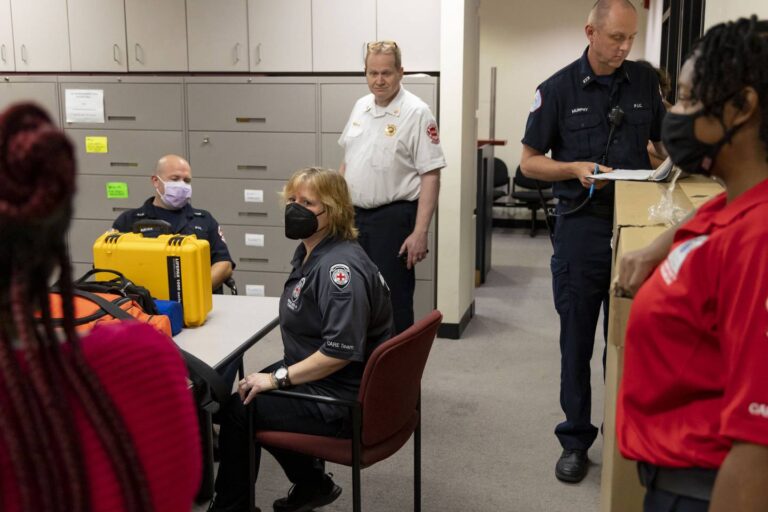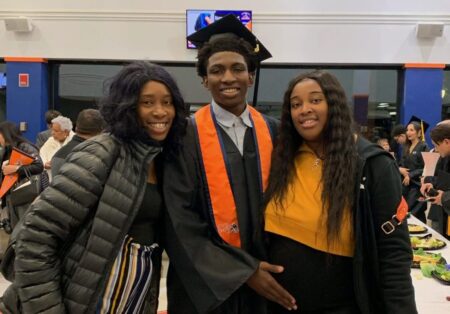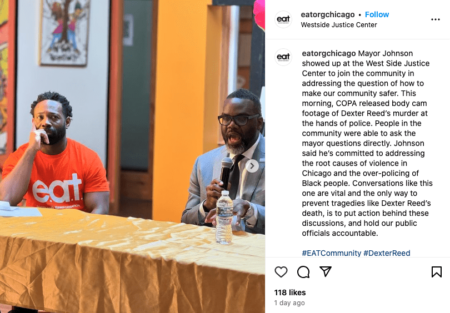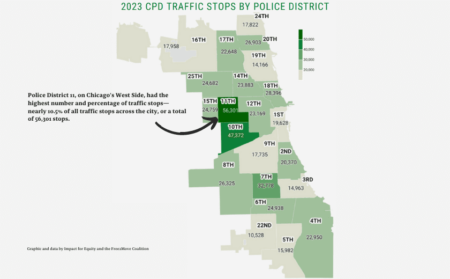A woman called 911, worried her friend might commit suicide after seeing a concerning photo on social media and thinking she may have slit her wrist.
When a mental health response team arrived at the friend’s home on Chicago’s South Side earlier this month as part of a new city effort, the team’s members were able to get the woman to talk to the team. The woman told them her daughter had died and her partner had left her.
Advertisement
“She didn’t want to die, but she had been trying to get help for so long, and different places that she called had given her the runaround,” said Gabrielle Mitchell, a mental health clinician with the response team, which now goes out on some Chicago 911 calls. “She really just wanted somebody to come and talk to her.”
In the weeks after the mental health team met the woman, she has set up a job interview and Mitchell has talked to her about going to counseling once she is employed.
Advertisement
The city’s Crisis Assistance Response and Engagement — or CARE — pilot program launched last fall, and some city officials and team members responding to calls say they’ve been able to help many people they’ve come in contact with. But the program has been limited in many ways, from the amount of days and hours the teams are out, to a lack of mental health providers the teams are able to work with to get people the help they need, team members said.
And community organizers and aldermen who have pushed for a nonpolice mental health response model over the last few years say the way the program has been designed is not what they had in mind.
Police have taken a lead in the CARE program when they should not be involved at all in matters that are a public health issue, some said.
Regionally, other police departments outside Chicago have also launched programs to address mental illness through treatment. Those programs don’t have a mental health professional in the same vehicle as an officer like the Chicago program does, but police and social workers are working together to connect people to treatment where they might have entered into the criminal justice system in the past.
On a recent Thursday morning in their office at a Chicago fire station in the South Loop, the teams of paramedics, mental health clinicians and officers prepared to go out in the vans for their shift. The three teams respond to calls Monday to Friday from 10:30 a.m. to 4 p.m.
The team discussed the case of a woman who doesn’t have a home or support system in Chicago and might need to get connected with the National Alliance for Mental Illness or a psychiatric hospital for services.
Advertisement
“While you’re trying to manage covering the bases, I’m trying to manage my resources,” said Tiffany Patton-Burnside, who supervises the clinicians for the Chicago Department of Public Health. She reminded the team to look into transferring the woman’s case to other organizations that can continue to help her.
“I just need y’all to not get so invested that ultimately you’re missing out on the next person that you can give this much passion to,” Patton-Burnside said.
The briefing is part of their morning routine. Afterward, the team members grabbed their equipment — and some clothes and shoes they give out to people in need — and headed out in three vans.
The type of calls the teams respond to differ based on the neighborhoods, the clinicians said. Jennifer Garross, a clinician who primarily works in Uptown and Lakeview, said ther team gets calls for mental health disturbances and calls from community partner agencies who need help taking a patient to a hospital. People also sometimes call when they are having suicidal thoughts or a psychotic episode and need treatment or hospitalization, Garross said.
Garross and her team have also been able to help just by being at the right place at a the right time.
One day, the team stopped in the 19th District police station for lunch. As they were eating, a trans woman walked into the station asking police to call an ambulance, Garross said.
Advertisement
“She felt like somebody was trying to poison her. She was very paranoid, thought people were following her,” Garross said. “My officer heard it and said, ‘Wait, what’s going on?’ And so we went out there and so we were able to engage with her.”
Garross talked to the woman privately and learned she’d just gotten out of the hospital and was already connected with Thresholds, a mental health organization. Garross connected her with a nearby Thresholds living room center, where she was able to get peer support and avoid hospitalization.
“When we went back the next day to follow up with her, she was doing much better,” Garross said. “She said that was exactly what she needed.”
Mitchell primarily works in Auburn Gresham and Chatham, where she said there are fewer service centers for the team to transport or refer patients. A lot of their calls come from concerned family members.
“They’ve been trying to manage them at home for some time,” Mitchell said. “Often, it’s years, sometimes it’s decades where … they’re not connected to any provider.”
Beyond getting the person hospitalized, Mitchell also works with families on case management and connecting them to resources.
Advertisement
“A lot of the time the call is (about someone) attempting suicide. Well, they want to kill themselves because they’re afraid to get evicted. They want to kill themselves because someone in their family was just murdered. They want to kill themselves because their lights are being turned off,” Mitchell said. “So it’s not as simple as getting them to the hospital.”
The teams that include a police officer have responded to 228 calls. However, 43% of the time, responders were not able to make contact with the individual, or the person refused service, according to the program’s data dashboard.
“Some of them are related to mental health disturbances in the community and they may be homeless. So a lot of times by the time we get there, they may have already left the scene,” Garross said of the calls.
People with mental health problems are 10 times more likely to be victims of violent crime than the general population, and only 3% to 5% of violent acts can be attributed to people with serious mental illness, according to the U.S. Department of Health and Human Services.
The idea for Chicago’s program started in 2019, when the then-Crisis Intervention Advisory Council made 33 recommendations to the city of Chicago, including one to develop alternate response models. In 2020 city officials started developing one, looking to similar programs in cities like Dallas, New York and Denver, among others.
Advertisement
The pilot program started in September with two teams made up of a mental health clinician, a paramedic and a crisis intervention team police officer who have been responding to calls in Lakeview and Uptown and in the Auburn Gresham and Chatham neighborhoods.
Last month, the city expanded the pilot program with a third team — its first operating without a police officer. That team responds to calls in the Southwest Side neighborhoods of Chicago Lawn, Gage Park, West Elsdon and West Lawn.
“It had to be a set of communities that consistently has the highest volume of 911 calls with a mental health component over a period of years,” said Matt Richards, deputy commissioner for behavioral health with the Chicago Department of Public Health. “We also felt very strongly that we wanted to bring an equity focus to this project so that diverse regions and populations of the city were being served by the pilot.”
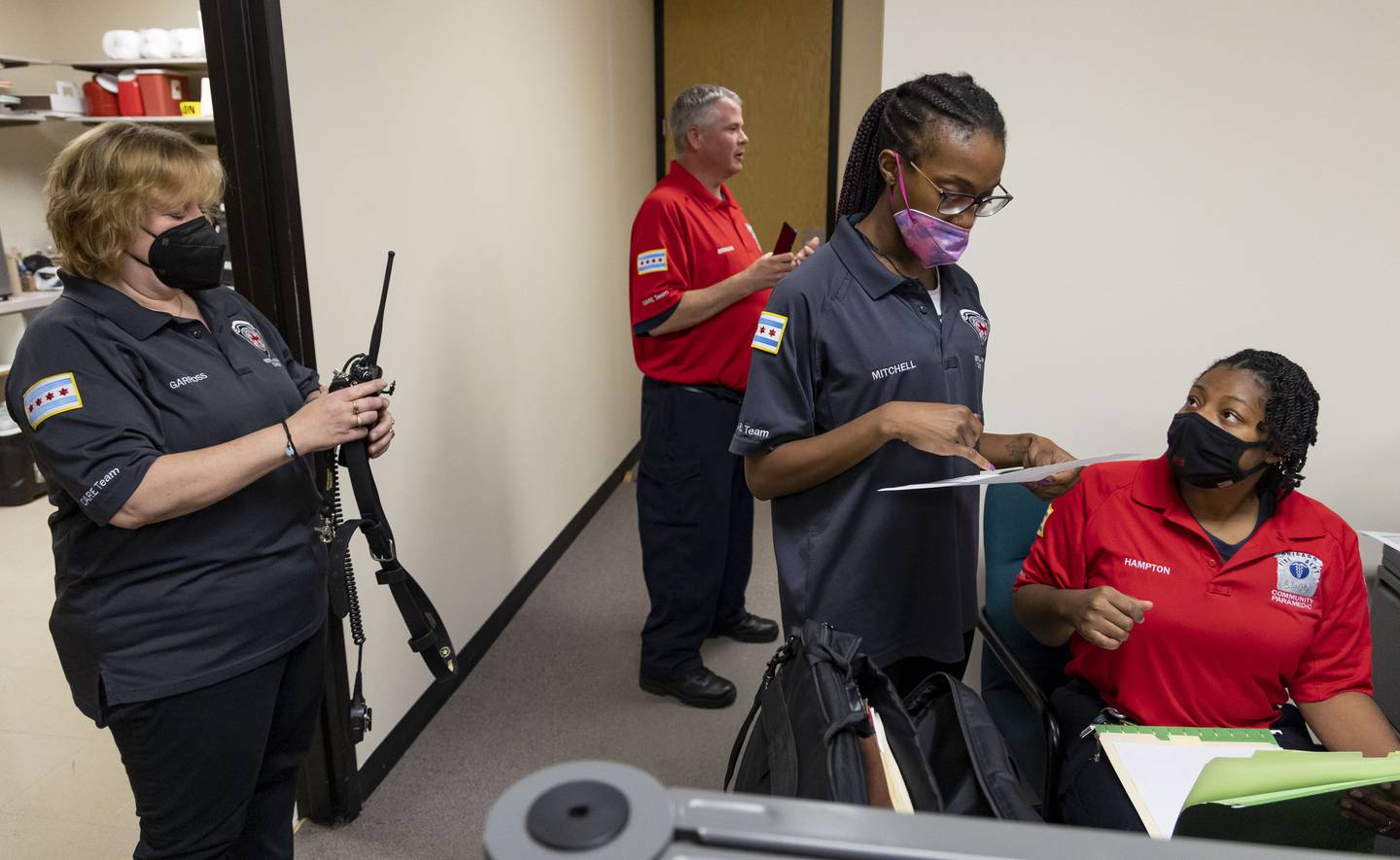
The pilot program costs between $3 million and $4 million a year and is largely funded through the city’s general operating fund, Richards said. The largest expense of the program is salaries, which are paid to team members through their corresponding departments. As part of the 2022 budget, city officials dedicated $15 million of the city’s $1.887 billion in American Rescue Plan federal funding for the program’s future expenses, Richards said.
Antoinette Ursitti, deputy chief of the Chicago Police Department’s Training and Support Group, which includes the crisis intervention unit, said the unit has for many years been involved in what was called the Crisis Intervention Advisory Committee, now the Chicago Council on Mental Health Equity. The committee’s recommendations made sense, Ursitti said.
Ursitti said city officials have spent a lot of time evaluating a wide range of 911 calls and determined that for some of those calls, it’s appropriate for an officer to accompany the mental health clinician “so that safe interaction can happen.”
Advertisement
“I think what we’re seeing here is that we are allowing for a number of different types of responses to meet the variety of needs for our residents here,” Ursitti said.
Similar programs in Cook, Lake and McHenry counties also provide access to social workers in response to emergency calls, but they do not go to the scene. Instead, in Cook County, sheriff’s deputies at the scene use smart pads to let agitated individuals talk to a counselor immediately, and in McHenry, police refer people to a social worker for follow-up.
The first 911 call under the Cook County program gives a good idea of the kinds of cases police are dealing with: a young man was trying to kill himself at home. When a sheriff’s deputy arrived, the family had broken into the man’s room and was piled on top of him, trying to prevent him from hurting himself.
Police separated the family members, tried to calm them down, and handed the man a smart pad to talk to a counselor. It turned out the man’s girlfriend had broken up with him, his grandmother had died that day, and he was addicted to pain pills.
Social worker and program director Elli Montgomery persuaded him to go to a hospital, where it took him three days to calm down — but it likely prevented him from more serious harm to himself.
“That really reinforced why we operate the way we do,” Montgomery said. “This lets a clinician lay eyes on the patient, but it doesn’t put additional people at the scene and cause more risk. It continues to give the officer their role to make sure a crime hasn’t been committed.”
Advertisement
The goal is to stabilize the person, de-escalate the situation, and alert police to what kind of help is needed.
The department has 150 smart pads, and the program is also offered in some suburban police departments, including Blue Island, Oak Lawn and Northbrook.
The county’s Treatment Response Team began in 2019 to help people with drug and alcohol addictions. In 2021, the program served 517 calls, and convinced 229 clients to get crisis intervention, counseling or referrals for mental health or substance abuse treatment.
Cook County sheriff’s police Sgt. Bonnie Busching said that initially, she was skeptical of adding another layer of bureaucracy to the chaotic situations she walks into.
But when she saw how it calmed down subjects without having to place hands on them or spend time and energy on repeat calls, she was a convert. “Now I’m calling them all the time,” she said.
Earlier this year, Lake County expanded its pilot program to follow up after 911 mental health calls with a team involving a police officer and a social worker, clinician or peer specialist for mental health-related calls. A sheriff’s deputy heads one pair, while a second crew used officers from one of six local police departments.
Advertisement
Since starting in 2018, the program has seen 3,300 people, and only 44 have been arrested, Sgt. Jim Yanecek said.
Many people having mental health breakdowns have been the subject of repeated police calls.
One woman in McHenry County called 911 about 100 times over three months, convinced demons were outside wanting to attack her.
Officers referred the case to social worker Alana Bak, who met with the woman and connected her to a counselor. The counselor was able to get the woman back on her medications, and she was able to find a stable home and get back on her feet.
Advertisement
Bak, who directs the program, has family in law enforcement. As a psychotherapist who’s worked with sex offenders and the severely mentally ill, she hopes the new program will help both the police and the people they are called to serve.
“I want to take the burden off police, and help people in their darkest hour,” Bak said.
The social workers do not typically handle negotiations with suspects, but may help police on the scene. Depending on the type of 911 call, police can refer people to social workers by phone or for follow up, or, in extreme cases, can call social workers to the scene, but not normally for risky situations.
Advertisement
At Chicago’s Emergency Communications Center, all 911 calls start on the police side and are either immediately transferred to fire if the person needs an ambulance or a fire truck, or are screened on the police side for a mental health component, Richards said.
If there is such a component, call-takers do a risk assessment to determine whether there is a weapon present, a crime in progress or a safety risk. Any one of those three factors make the call ineligible for a CARE team to respond, Richards said.
Without a risk component, a CARE team can be dispatched if it’s available and if the response falls within the neighborhoods the teams are focused in.
The limited service area and time the CARE teams are available for is just one of several limitations that have come up. Mitchell and Garross said the city could use more mental health services and facilities, especially on the South Side.
They said while there are therapists available, there can be a three-to-four-week wait for someone to see a psychiatrist, which is required for someone to get prescribed medication.
“It’s really hard in the moment when you’re doing crisis work and what they need is that medication refill or just to be evaluated by a psychiatrist,” Garross said.
Advertisement
None of the calls the co-response teams have responded to have resulted in use of force or arrests, according to the data dashboard, something Richards said shows the program’s success so far.
“I think that it’s showing that we are able to safely address residents’ mental health needs by leading with a health care-focused response,” he said.
But Ald. Rossana Rodriguez Sanchez, 33rd, who was part of a group of City Council members who requested a nonpolice response model, says the data proves police are unnecessary and should not be part of the mental health response teams.
Advertisement
The officer on the team clears the scene, ensuring it’s safe before the paramedic and clinician come in to talk to the patient, Richards said.
“So what we are doing is we are delegating in police officers to decide if the clinician should be the one interacting with somebody at some point. And police does not have training for that,” Rodriguez Sanchez said. “The clinicians are the ones that have training to assess how safe or not safe somebody that is experiencing a mental health crisis is and the ability to de escalate. So we need a program that is run by clinicians, not police.”
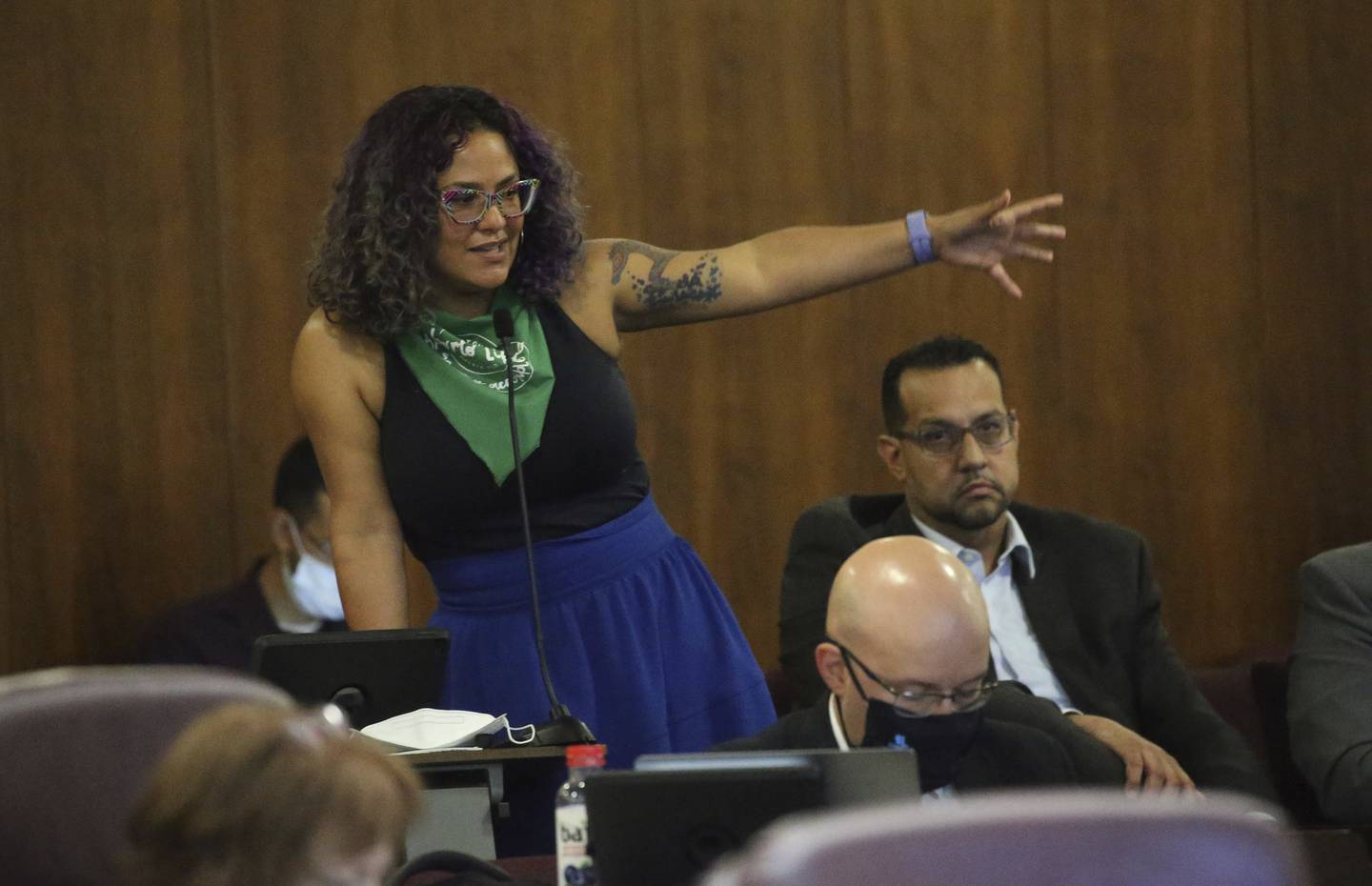
Arturo Carrillo, director for health and violence prevention with the Brighton Park Neighborhood Council and a co-lead for the Collaborative for Community Wellness Coalition, said the city’s program also forces people to call 911 for help, which some people, especially in communities of color, might not be comfortable doing.

Afternoon Briefing
Daily
Chicago Tribune editors’ top story picks, delivered to your inbox each afternoon.
The city’s limited resources also don’t guarantee that a person will get a nonpolice response team or any mental health response team if they do call, Carrillo said.
“It’s such a minuscule program,” Carrillo said.
Advertisement
Carrillo said the city’s Department of Public Health also failed to reach out for community input in putting together the program. He said the Police Department had a heavy hand in leading and planning the co-response model.
The Department of Public Health is now looking at launching a third model under the program where a paramedic and a peer recovery specialist will respond to substance use calls on the West Side, Richards said. That model is expected to launch late summer or early fall.
City officials are also looking at expanding the program with second shifts and expanding to other areas of the city that have a high volume of 911 calls with a mental health component, Richards said. Mental health clinicians are also now in the 911 center helping call takers ask the right questions to determine whether there’s a mental health component to a call.
But questions remain about whether it’s enough. Rodriguez Sanchez said what Chicago needs is a nonpolice response model that integrates public mental health clinics.
“We are asking for a model that is way bigger, that can actually address the needs of our communities,” she said. “What they’re doing right now is so little. … It’s inadequate, it’s insufficient. We need way more than this.”




